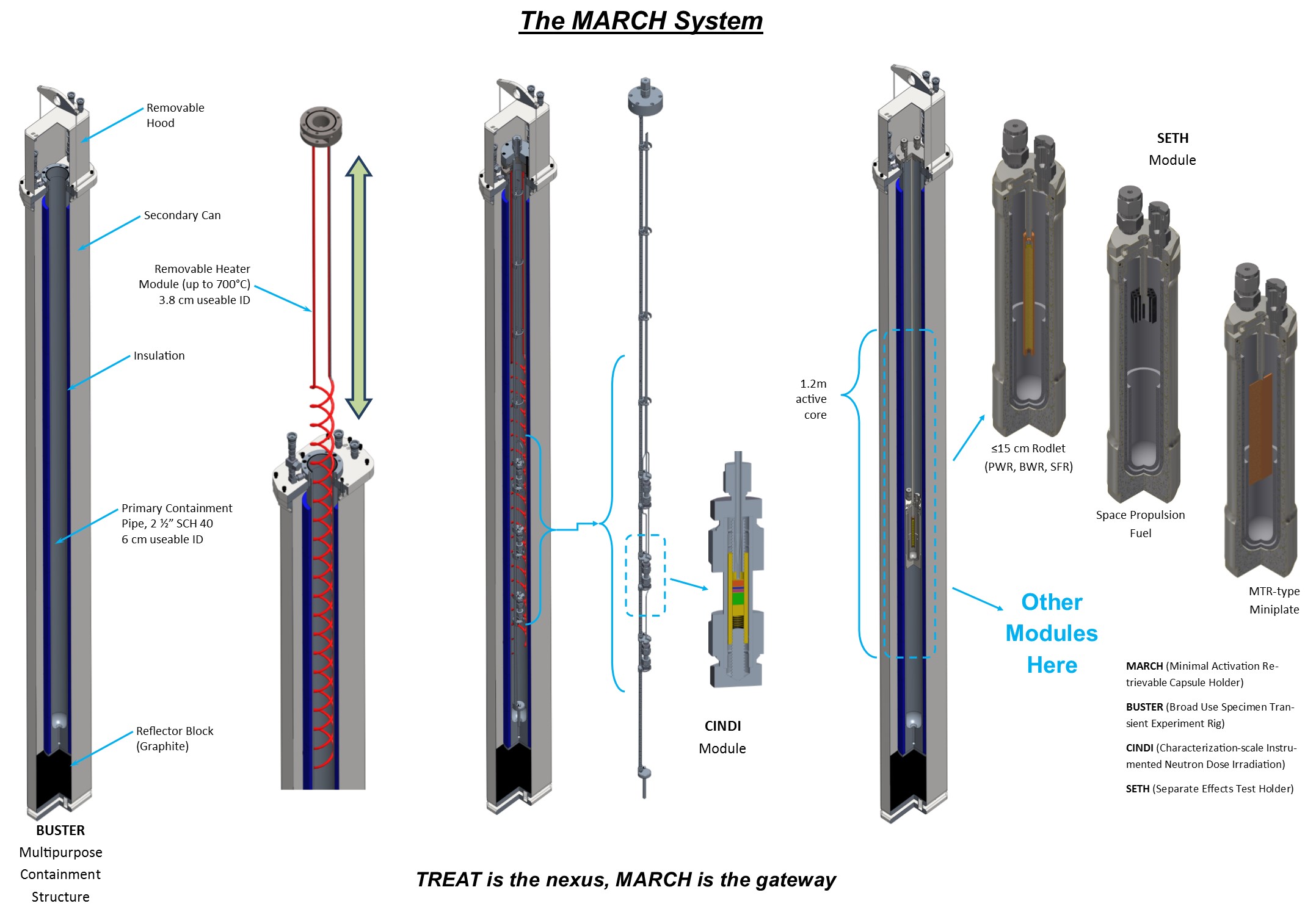The Minimal Activation Retrievable Capsule Holder

Mission statement
Provide a modular irradiation vehicle system that enables transient irradiation of nuclear materials, instruments, and small fuel samples for affordable science-based, separate-effects, and semi-integral scale testing that can undergo post-transient exams within weeks of irradiation.
System description
The Minimal Activation Retrievable Capsule Holder (MARCH) irradiation vehicle system groups common objectives into multipurpose modules that can be configured in various ways. The heart of the design is a reusable stainless steel containment structure, termed the Broad Use Specimen Transient Experiment Rig (BUSTER), which constitutes the reactor core thermal/mechanical interface and serves as the credited safety containment. This permit enables modules within to be designed with flexibility in material selection and operating conditions. BUSTER can also be configured in single- or double- containment mode, the latter being required for transuranic-bearing specimens.
An optional heater module can be placed within BUSTER for elevated temperature testing. Experiment capsules and modules can be placed within BUSTER for various purposes. While not credited as the safety containment, these capsule modules function as hermetic containers to control radiologic contamination during irradiation and shipping. Capsules are made from low-activation materials that can easily be extracted when BUSTER is placed in shielded storage holes. When combined with small specimen sizes and brief irradiation durations, these capsule can typically be extracted and shipped for post-transient exams within weeks of irradiation in facilities with minimal shielding (e.g., gloveboxes).
Applications
Many capsule module designs exist or are underway for use in the MARCH system. Example capsule designs are summarized below:
CINDI (Characterization-Scale Instrument Neutron Dose Irradiation): Several small characterization-scale (up to 5 mm in diameter) fuel or material samples can be placed in capsules equipped with temperature monitoring and mechanical layout to allow assembly in transuranic gloveboxes. Used in conjunction with the heater module, CINDI capsules enable well-monitored irradiations that produce data ideal for comparison to lower-length modules of fundamental irradiation damage mechanisms.
SETH (Separate Effects Test Holder): SETH is a larger capsule suitable for irradiation of small power-reactor rodlets (≤10 cm fuel length), compacts, extrusion, plates, etc. SETH-based tests leverage its low-cost consumable components, conventional compression instrument seals, and predictable specimen environment (inert gas) for affordable concept screening, separate-effects, and phenomena-identification fuel irradiations.
MARCH-SERTTA (Water-Filled Capsule) (Click to go to website)
MIMIC (Materials and Instrument Modular Irradiation Capability): MIMIC is an adjustable hardware rack used to position instrumentation or other materials in desired core locations. MIMIC is paired with an analysis tool that quickly calculates experiment operating parameters, which are based on composition and quantity of specimen materials alone. MIMIC can be used to evaluate the instrument survival under acute neutron/gamma dose and signal response in nuclear environments that range by several orders of magnitude.
THOR (Temperature Heat-Sink Overpower Response): THOR is a thick-walled capsule in which rodlet type fuel specimens are "bonded" with liquid metal for intimate thermal transport. This makes it possible to serve as a heat sink for longer-shaped transients and other temperature response-shaping strategies. Paired with temperature and elongation sensors, THOR approximates the postulated thermal response of specimens in reactor plants in a compact and affordable test package.
TTD (Tensile Test Device): Bellows-based load mechanism uses the BUSTER pipe as a load frame so that, combined with load/displacement sensors, mechanical property testing can be performed on small specimens under the presence of varying levels of neutron/gamma bombardment.
Specifications
Heater module maximum temperature: 700°C
Useable test diameter in BUSTER: 6.0 cm (3.8 cm with heater module)
Useable active core length in BUSTER: 1.2 m*
*Depending on shipping container and logistics plan, capsule lengths may be limited to ~0.5 m